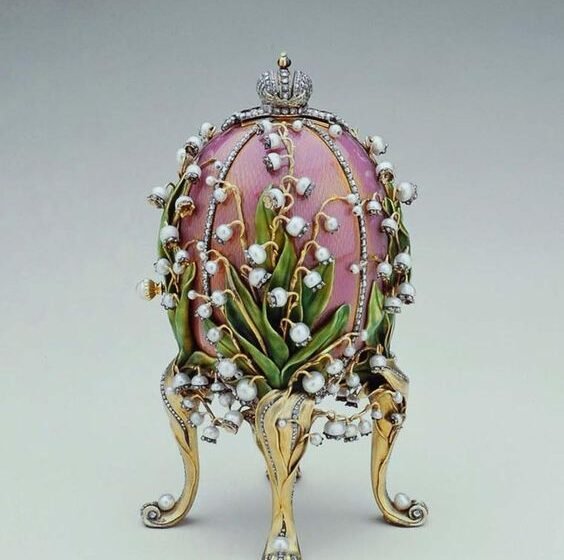Eggceptional Craftsmanship: The Enchantment of Fabergé Eggs
- Lifestyle Ancient history Asian history European history
 Amaan Bakhsh
Amaan Bakhsh- March 21, 2024
- 0
- 114

In 2002, an egg was sold for 9.6 million dollars. Shocking, right? But this was no ordinary egg – In fact, it was a rare Fabergé egg, called the “1913 Winter Egg”. This blog will explore the history of these remarkable eggs and what makes them worth millions today. Fabergé eggs are among the most exquisite works of art ever created. These masterpieces, originating from the House of Fabergé in Russia, have represented luxury, craftsmanship, and innovation for nearly a century. Conceived by Peter Carl Fabergé, a renowned Russian jeweler, the Fabergé eggs were commissioned as Easter gifts for the Russian imperial family, specifically Tsar Alexander III and later his son, Tsar Nicholas II, from 1885 to 1917.

As many as 69 Fabergé eggs were originally created, with 57 of them still surviving today, a testament to their enduring allure. Virtually all of these exquisite creations were meticulously crafted under the direct supervision of Peter Carl Fabergé himself. Among these treasures, the most renowned are the 52 “Imperial” eggs, of which an impressive 46 have withstood the test of time. These Imperial eggs hold a special significance, as they were commissioned by the Russian emperors Alexander III and Nicholas II as Easter gifts for their wives and mothers. This adds layers of sentimentality and historical context to their already extraordinary beauty.
Each Fabergé egg is a masterpiece of design and ingenuity, boasting superb details and unparalleled craftsmanship. Adorned with precious metals and an array of gemstones, these eggs are valued at millions of pounds each, making them highly coveted by collectors and enthusiasts worldwide. Beyond their monetary worth, Fabergé eggs have transcended their material value to become iconic symbols of opulence, elegance, and refined taste.
Every single Fabergé egg is a marvel of meticulous detail and opulence. They are typically crafted from precious metals like gold or silver and adorned with an array of precious gemstones, including diamonds, red rubies, emeralds, and green sapphires. What truly sets these eggs apart is their ingenious design, often featuring enamel work, guilloché patterns, and miniature portraits.

The first Fabergé egg, known as the Hen Egg, was created in 1885 for Tsar Alexander III to present to his wife, Empress Maria Feodorovna, as an Easter gift. This inaugural masterpiece set the standard for all subsequent eggs, featuring a white enamel shell adorned with gold and precious gemstones, which opened to reveal a golden yolk containing a miniature replica of the imperial crown and a tiny ruby pendant. Notably, this surprise element became a hallmark of Fabergé eggs, with each subsequent creation featuring a unique surprise concealed within.
Over the years, the Fabergé eggs became treasured symbols of the Romanov dynasty’s wealth and power, while also showcasing the unparalleled skill of Russian artisans. However, the revolution of 1917 brought an end to the imperial era in Russia, leading to the downfall of the Romanovs and the eventual closure of the House of Fabergé. Many of the Imperial eggs were seized by the Bolsheviks and subsequently sold or dispersed around the world.
Despite their tumultuous history, Fabergé eggs continue to captivate collectors and enthusiasts worldwide. The rarity and exquisite beauty of these objects have made them highly sought after, with individual eggs fetching millions of dollars at auction. Today, Fabergé eggs can be found in prestigious museums, private collections, and even among the crown jewels of various royal families.Beyond their monetary value, Fabergé eggs hold a significant cultural and historical importance. They serve as tangible reminders of a bygone era, offering insight into the lavish lifestyles of the Russian aristocracy.

The Fabergé eggs still stand as enduring testaments to the enduring legacy of Peter Carl Fabergé and the artisans of his workshop, whose unparalleled craftsmanship continues to inspire awe and admiration to this day. These eggs have become cultural touchstones, inspiring fascination and admiration across generations. The following are five important Fabergé eggs that have played a role in the history of luxury.
Firstly, the Imperial Coronation Egg of 1897 stands out prominently. It is an enduring testament to the opulence and splendor of the Russian imperial court. Commissioned by Tsar Nicholas II to mark his coronation and presented to his wife, Empress Alexandra Fyodorovna, this egg exemplifies the exquisite craftsmanship and attention to detail characteristic of Fabergé’s creations. Tsar Nicholas II was the last Emperor of Russia, who ruled from 1894 until his abdication in 1917. His reign was marked by political turmoil, economic hardship, and social unrest.

Despite his initial popularity, Nicholas faced criticism for his autocratic rule and failure to address the growing discontent among the Russian people. His involvement in World War I further weakened his position, leading to the February Revolution and ultimately the fall of the Romanov dynasty. Nicholas’s abdication paved the way for the establishment of a provisional government and ultimately the Bolshevik seizure of power, marking the end of centuries of tsarist rule in Russia.
Despite this tumultuous past of the Tsar himself, the egg stands out for its beauty and embodiment of luxury. The egg’s translucent yellow enamel shell, accented with diamond and ruby embellishments, captures the eye with its radiant beauty. However, it is the surprise concealed within that truly elevates this masterpiece to extraordinary heights. Upon opening the egg, one is greeted by a stunning miniature replica of the Russian imperial coach, meticulously crafted in intricate detail. This Imperial Coronation Egg commemorates a momentous occasion in Russian history. It is a tangible reminder of the grandeur and pomp of the imperial coronation ceremonies, offering a glimpse into a bygone era of extravagance and royal magnificence.
Secondly, the Imperial Lilies of the Valley Egg of 1898 stands as a witness to the love and affection between Tsar Nicholas II and Empress Alexandra Fyodorovna. This beautiful creation, commissioned by the Tsar as an Easter gift for his beloved wife, is celebrated for its remarkable craftsmanship and vital design.
The egg’s exterior is adorned with delicate and lifelike lilies of the valley, meticulously crafted from gold, enamel, and diamonds. Each petal and leaf is rendered with remarkable attention to detail, capturing the natural beauty of the flowers in stunning clarity.. Upon opening the egg, one discovers a heart-shaped locket containing miniature portraits of the Empress Alexandra’s children— a touching tribute to the bond between mother and children, and a cherished memento of family love and unity.

The Imperial Lilies of the Valley Egg serves as a symbol of the Tsar’s affection for his wife and his family. Today, it remains a treasured masterpiece, revered for its beauty, craftsmanship, and sentimental value.
Next, the Imperial Peter the Great Egg of 1903 is a remarkable testament to the enduring legacy of one of Russia’s most iconic rulers. Crafted under the supervision of Peter Carl Fabergé, this egg pays homage to the visionary leader, Peter the Great, who left an indelible mark on Russian history .Peter the Great, was a towering figure of the late 17th century in Russian history. He, left an indelible mark on his nation’s history. Ascending to the throne in 1682 at the age of just ten, Peter’s reign was characterized by sweeping reforms and modernization efforts aimed at transforming Russia into a modern power on Western lines.
Renowned for his towering stature, boundless energy, and insatiable curiosity, Peter embarked on ambitious campaigns to modernize Russia’s military, economy, and society. He initiated a series of radical reforms, including the creation of a professional army, the establishment of a modern navy, and the introduction of Western-style education and technology.Under Peter’s leadership, Russia expanded its borders and emerged as a formidable force on the European stage. His visionary policies laid the foundation for Russia’s transformation into a major European power, securing his legacy as one of the most influential figures in Russian history.

It was for a King like Peter that this egg was created. The egg commemorates the 200 year anniversary of the founding of the city of St.Petersburg by King Peter. Constructed from the finest materials, including gold, enamel, and diamonds, the egg is adorned with intricate engravings depicting significant events from Peter the Great’s reign. From his modernization efforts to his military conquests, each detail on the egg tells a story of Peter’s remarkable achievements and enduring influence.
Upon opening the egg, one is delighted to discover a miniature bust of the emperor, meticulously crafted with astonishing precision. This exquisite addition serves as a poignant reminder of Peter the Great’s profound impact on Russian culture and history.
The Imperial Rosebud Egg of 1895 stands out as one of the earliest Imperial eggs. It holds a special place in the hearts of collectors and enthusiasts alike. Its pink enamel exterior, adorned with intricate gold ribbons and sparkling diamonds, exudes a sense of refinement and sophistication.
However, it is the hidden surprise concealed within the egg that truly captures the imagination. Upon opening the egg, one is delighted to discover a delicate rosebud crafted from gold and enamel—a symbol of love, beauty, and renewal. The meticulous attention to detail and craftsmanship showcased in this miniature masterpiece is a testament to the skill and dedication of Fabergé’s artisans. The Imperial Rosebud Egg encapsulates the romanticism and elegance of the Russian imperial court.
Lastly, the Imperial Trans-Siberian Railway Egg of 1900 is a remarkable appreciation of the technological progress and engineering marvels of its time. Commissioned to commemorate the completion of the Trans-Siberian Railway—an ambitious project that connected Russia’s vast expanse from Moscow to Vladivostok—this egg is a masterpiece of craftsmanship and ingenuity.

The Imperial Trans-Siberian Railway, completed in 1900, stands as one of the most ambitious engineering feats of the 19th century. Stretching over 5,700 miles across the vast expanse of Russia, it connected Moscow to Vladivostok, opening up remote regions to trade, travel, and development. This monumental project, initiated by Tsar Alexander III and completed under Tsar Nicholas II, played a crucial role in unifying the Russian Empire while facilitating economic growth and cultural exchange.
Distinguished by its intricate detail and mechanical features, the egg captures the imagination with its exquisite design. Crafted from precious metals and adorned with diamonds and enamel, it is a stunning work of art in its own right. However, it is the hidden surprise concealed within the egg that truly sets it apart. Upon opening the egg, one is astonished to discover a miniature train crafted from gold, complete with diamond headlights and enameled carriages. This intricately detailed replica pays homage to the Trans-Siberian Railway, symbolizing the progress and modernization sweeping across Russia at the turn of the century.
In conclusion, the legacy of Fabergé eggs transcends mere craftsmanship and opulence, because it weaves together history, artistry, and culture. These miniature marvels stand as timeless symbols of the grandeur and extravagance of the Russian imperial court, captivating the imaginations of collectors and enthusiasts worldwide. Each egg tells a story, whether through its design, historical context, or hidden surprises; and in doing so, it offers a window into a bygone era of splendor and refinement. As cherished treasures that have survived the test of time, Fabergé eggs continue to inspire wonder and admiration, serving as enduring testaments to the enduring legacy of Peter Carl Fabergé and the artisans of his workshop.


